![]()
![]()
![]()
Use LEFT and RIGHT arrow keys to navigate between flashcards;
Use UP and DOWN arrow keys to flip the card;
H to show hint;
A reads text to speech;
45 Cards in this Set
- Front
- Back
|
What is our first line of defense in the immunology chain?
|
Skin, skin, skin!
|
|
|
What is the humoral immune response?
|
immune response that occurs in the humor of bodies: interstitial spaces, blood, lymph, epithelial surfaces
|
|
|
What are the humoral players?
|
antibodies, complement, phagocytosis
|
|
|
Where does a cell-mediated immune response take place?
|
cytoplasm, vessicles
|
|
|
What is the progression of immune system involvement?
|
Physical and chemical barriers, innate immune system, adaptive immune system
|
|
|
What are the three progenitor cells derived from bone marrow hematopoietic stem cells?
|
lymphoid progenitor, myeloid progenitor, erythroid progenitor
|
|
|
What cells are derived from the common lymphoid progenitor cells?
|
B cells that become plasma cells, NK cells, T cells that become effector T cells
|
|
|
What cells are derived from the myeloid progenitor cells?
|
leukocytes - neutrophil, eosinophil, basophil, monocytes to macrophages, mast cells, dendritic cells
|
|
|
What cells are derived from the erythroid progenitor cells?
|
megakaryocytes to platelets, and erythroblasts to erythrocytes
|
|
|
How does the immune system differentiate self from non-self?
|
"Pattern recognition receptors" located on macrophages and neutrophils relative to phagocytes in innate immunity. "Somatically generated receptors" relative to T and B cells in adaptive immunity.
|
|
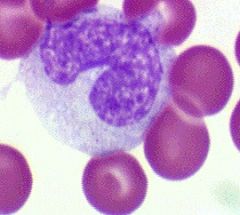
What is this?
|
phagocyte in bloodstream (monocyte) and in tissue (macrophage). horseshoe shaped nucleus
|
|
|
What is the significance of a PRR?
|
Pattern recognition receptors recognize PAMPs (pathogen-associated molecular patterns) that are frequently found on bacteria, viruses, and fungi. When PRRs bind PAMPs, they enhance phagocytosis and cytokine secretion.
|
|
|
What are the macrophage PRRs?
|
mannose receptors, Toll-like receptors, LPS receptors (CD14), CR3, scavenger receptor, glucan receptor
|
|
|
What happens when TLRs are activated
|
TLRs are toll-like receptors which are PRRs located on macrophages. When they are activated, they increase phagocytotic activity and cytokine secretion. Cytokines such as TNF-alpha
|
|
|
By what mechanisms are phagocytosis enhanced?
|
oxygen-dependent respiratory burst and oxygen-independent lysing
|
|
|
What is oxygen-dependent phagocytotic enhancement?
|
A type of phagocytotic enhancement that occurs when PRRs bind PAMPs by "repsiratory burst." NADPH oxidase generates toxic oxygen radicals. Myeloperoxidase helps out by converting hydrogen peroxide to hyperchlorite.
|
|
|
What is oxygen-independent phagocytotic enhancement?
|
A type of phagocytotic enhancement that occurs when PRRs bind PAMPs by increasing lysozimal activity: lysozymes, defensins, lactoferrin, hydrolytic enzymes, acidic pH.
|
|
|
How is Chronic Granulomatous relevant to PRRs and PAMPs?
|
this condition is relavant because there is an inherited deficiency in NADPH oxidase so that oxygen-dependent phagocytosis enhancement is impaired.
|
|
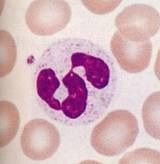
Identify!
|
characteristic multi-lobed nucleus. sausage links on a string. macrophages release CXCL8 to call upon the power of the neutrophil. they are a phagocyte and upon death, form pus. neutrophils are NOT in healthy tissue.
|
|
|
What is the process of neutrophil activation?
|
Neutrophils are stored in bone marrow and only come into tissue when macrophage release CXCL8. Neutrophils engulf and kill pathogens, die in the tissue, and are disposed of by the macrophage.
|
|
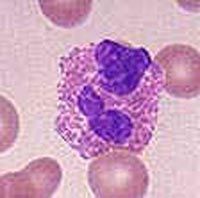
Identify!
|
bi lobed with large pink granules - eosinophil
|
|
|
What basic function to eosinophils play?
|
defend against intestinal parasites, allergies and asthma by releasing cytokines, and calling ROS by degranulating
|
|

Identify!
|
bilobed nucleus, large blue granules - basophil!
|
|
|
What is basophils basic function?
|
release histamine and other cytokines. play a big role in allergies.
|
|
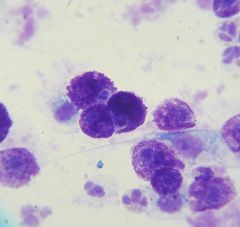
Identify!
|
small nucleus, large blue granules - mast cell. basically basophils in tissue. releases histamine and involved in allergies.
|
|
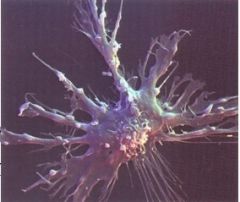
Identify!
|
Dendritic Cell - APC. found in epithelial tissue that contacts environment and after activated, migrates to lymphoid tissue.
|
|

Identify!
|
lymphocyte - large dark nucleus, small rim of cytoplasm
|
|
|
what are lymphocytes basic function?
|
involved with adaptive immunity:
humoral - B cells cell mediated - T cells NK cells |
|
|
what is the basic role of B cells?
|
in humoral immunity, B cells secrete antibodies
|
|
|
what is the basic role of T cells?
|
in cell-mediated immunity, T cells can be helper T cells (cytokines) or cytotoxic T cells (kill T cells)
|
|
|
what is the basic role of NK cells?
|
to KILL, bwahahahaha! they do this by releasing granules full of perforins and granzymes to induce apoptosis. they also release cytokines to keep the love going.
|
|

Identify!
|
NK cells with a large dark nucleus, and large cytoplasmic granules
|
|
|
Put in descending order of volume in the body: neutrophil, eosinophil, basophil, monocyte, lymphocyte.
|
neutrophil
lymphocyte monocyte eosinophil basophil |
|
|
What is the function of lymphatic organs?
|
to collect and filter pathogens from the lymph before the lymph is dumped back into the blood stream
|
|
|
Primary Lymph Tissue
|
where cells go to mature: bone marrow (maturation of B cells), thymus (maturation of T cells)
|
|
|
Secondary Lymph Tissue
|
where cells are called to act: lymph nodes, spleen, MALTs, GALTs, BALTs
|
|
|
Lymph node structure
|
lymph enters from outer capsule, is filtered through the cortex and then is pushed out of the central efferent lymph vessel to continue through lymph circulation
|
|
|
Spleen
|
filters blood like lymph nodes filter lymph.
red pulp - filters to remove RBCs white pulp - filters foreign Ag and activates adaptive immune response |
|
|
MALTs (mucosal assocated lymphoid tissue)
|
encounter Ag as they pass though mucosal epithelium. Contains macrophages, B cells and T cells. every *ALT is a MALT
|
|
|
GALT (gut assocated lymphoid tissue) specific example
|
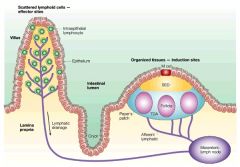
Peyer's Patch: Villi in the lamina propria have lymph vessels that drain that tissue, so Ag effuses into M cell and then goes to a mesenteric lymph node and finds on the other side B, T and macros
|
|
|
General cytokine effects
|
increase blood flow, recruit immune related cells, activate immune related cells, induce fever
|
|
|
Type I Interferons
|
IFN-alph, IFN-beta produced by any virus-infected cell to notify neighbors to stay safe and flag themselves for destruction
|
|
|
Type II Interferon (IFN-gamma)
|
secreted by T cells, NK cells, and dendritic cells as antiviral, antitumor
|
|
|
probiotics
|
intestinal bacteria that are our friends
|
|
|
Route of infection where splinter causes puncture wound
|
1) physically breaks first line of defense (skin)
2) chemical defense: complement (alternative during innate response) 3) cellular defense - macrophage 4) 2nd line cellular defense - neutorphils recruited by macrophage cytokine CXCL8 |

